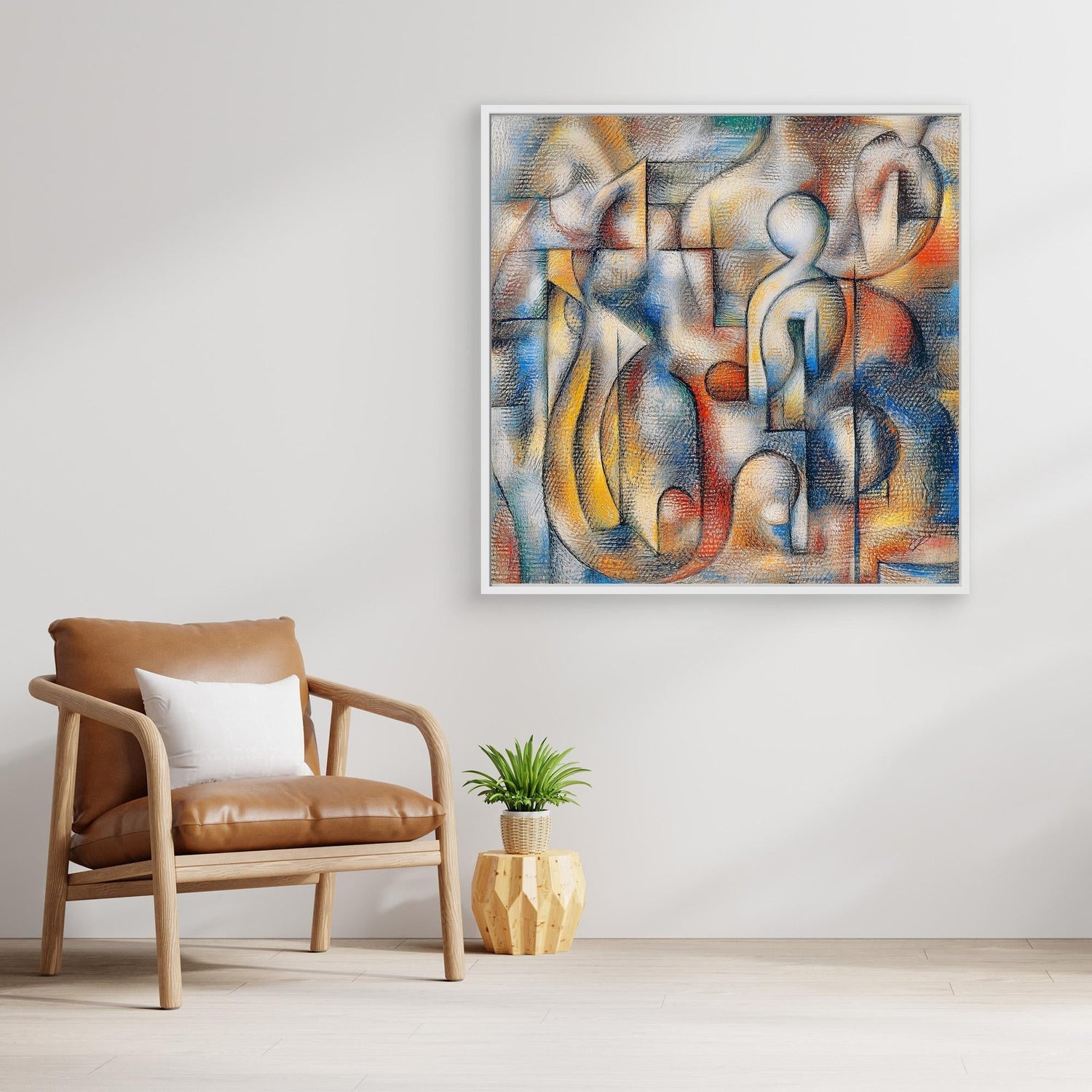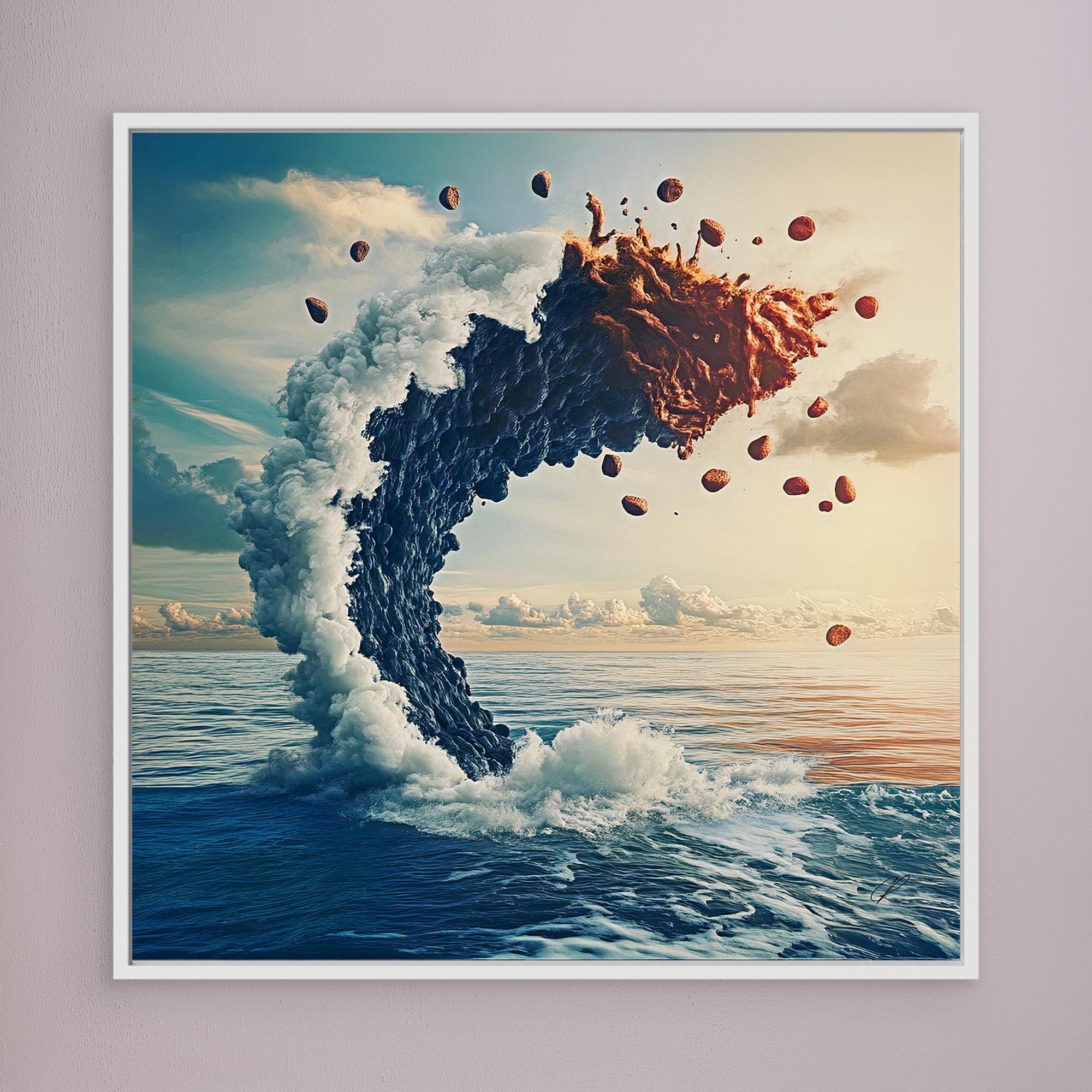Abstract art, a fascinating and complex art form, has captivated audiences for over a century. It challenges the viewer to look beyond the surface and delve into the depths of emotion, thought, and imagination. This type of art is known for its ability to evoke feelings and provoke thought without relying on realistic depictions. The journey of abstract art has been marked by significant movements, influential artists, and an enduring legacy that continues to shape the art world today.
What is Abstract Art and How Did It Evolve?
Defining Abstract Art
Abstract art is a non-objective type of art that departs from traditional representation. Instead of depicting objects or scenes from the natural world, abstract art uses colors, shapes, and forms to achieve its effect. This form of art can be understood as an exploration of the interaction between these elements, often creating a visual experience that is open to interpretation. The purpose of abstract art is not to mirror reality but to invite the viewer to engage with the artwork on a more personal and emotional level.
The Historical Evolution of Abstract Art
The evolution of abstract art can be traced back to the late 19th and early 20th centuries, when artists began to experiment with new approaches to painting and sculpture. Pioneers like Wassily Kandinsky, often credited with creating the first abstract painting, sought to convey the "spiritual in art" through abstraction. The early 20th century saw the emergence of various movements, such as Cubism and Surrealism, which laid the groundwork for the abstract art movement. Over time, abstract art evolved, incorporating diverse styles and philosophies, leading to the rich tapestry of abstract works we see today.
Key Movements in the Development of Abstract Art
Several key movements have played a crucial role in the development of abstract art. The abstract expressionism movement, which emerged in the 1940s and 1950s, was marked by its emphasis on spontaneous, expressive brushwork. Artists like Jackson Pollock and Willem de Kooning embraced action painting, a dynamic and physical approach to creating abstract pieces. Another significant movement was Color Field Painting, exemplified by artists such as Mark Rothko, who focused on large expanses of color to evoke emotion. These movements, along with geometric abstraction led by figures like Piet Mondrian, contributed to the rich diversity of abstract art.
What Are the Main Characteristics of Abstract Art?
Understanding the Elements of Abstract Art
The characteristics of abstract art are defined by its departure from realistic representation. Abstract artworks rely heavily on the use of line, form, color, and texture to convey meaning. These elements are often manipulated to create abstract images that invite individual interpretation. The lack of recognizable subjects in abstract painting encourages viewers to engage with the art on a deeper, more intuitive level, allowing for a personal connection with the piece.
The Role of Color, Shape, and Form
In abstract art, color, shape, and form are paramount. Color is often used to evoke emotions and create mood, with artists like Kandinsky and Rothko exploring the psychological effects of different hues. Shapes and forms are used to create balance, tension, and movement within the composition. The interplay of these elements is what gives abstract art its unique ability to communicate beyond words, reaching into the realm of pure experience and sensation.
How Abstract Art Differs from Realistic Art
Abstract art differs from realistic art in its approach to representation. While realistic art aims to depict subjects as they appear in the natural world, abstract art focuses on the essence and emotion behind the subject. This shift allows abstract artists to convey ideas and feelings that are not bound by the constraints of realism. By moving away from literal representation, abstract works challenge viewers to engage with the art on a personal level, interpreting it through their own experiences and emotions.
Why Was Abstract Expressionism Important?

The Rise of Abstract Expressionism
Abstract expressionism emerged in the mid-20th century as a revolutionary movement that reshaped the art world. It was the first American art movement to gain international influence, marking a shift in the center of the art world from Europe to the United States. This movement emphasized personal expression and spontaneity, with artists using bold, gestural techniques to convey emotion. The rise of abstract expressionism was driven by a desire to break free from traditional artistic constraints and explore new ways of creating and experiencing art.
Influential Abstract Expressionist Artists
Several artists were instrumental in the development of abstract expressionism. Jackson Pollock, known for his drip paintings, revolutionized the way paintings were created by using unconventional techniques. Willem de Kooning's dynamic brushwork and expressive forms further pushed the boundaries of abstraction. Mark Rothko's color field paintings, characterized by large blocks of color, conveyed deep emotional resonance. These artists, along with others like Helen Frankenthaler and Franz Kline, were pivotal in defining the abstract expressionist movement and its impact on subsequent generations of artists.
Impact on the Art World
The impact of abstract expressionism on the art world was profound and far-reaching. It challenged traditional notions of art, paving the way for new art forms and movements. The emphasis on personal expression and experimentation inspired a generation of artists to explore new techniques and ideas. Abstract expressionism also played a crucial role in establishing New York City as a major center for the arts, influencing contemporary abstract artists and shaping the direction of modern art.
What Are the Different Types of Abstract Art?

Exploring Geometric Abstraction
Geometric abstraction is a type of abstract art characterized by the use of geometric shapes and forms. Artists like Piet Mondrian and Kazimir Malevich explored the use of simple geometrical forms to convey complex ideas and emotions. This style emphasizes order, balance, and harmony, often employing a limited color palette to create a sense of clarity and precision. Geometric abstract works challenge viewers to engage with the art on both an intellectual and emotional level, inviting contemplation of the underlying structure and meaning.
Understanding Action Painting
Action painting is a dynamic and energetic form of abstract art that emerged during the abstract expressionism movement. This style is characterized by the spontaneous application of paint, often with the artist physically engaging with the canvas. Jackson Pollock's drip techniques and Willem de Kooning's vigorous brushwork are quintessential examples of action painting. This approach emphasizes the process of creation, with the act of painting itself becoming an integral part of the artwork. Action painting captures the immediacy and energy of the artist's movements, resulting in compositions that are both visceral and expressive.
The Role of Abstract Photography
Abstract photography explores the boundaries of traditional photography by focusing on elements such as shape, form, color, and texture, rather than representational subjects. This type of abstract art challenges the conventional perception of photography as a medium for realistic depiction, pushing the viewer to see beyond the literal. Abstract photographers manipulate light, perspective, and composition to create images that evoke emotion and provoke thought, blurring the lines between reality and imagination.
How Does Abstract Art Remain Popular Today?

The Influence of Abstract Art in Contemporary Art
Abstract art continues to influence contemporary art, with many artists drawing inspiration from its rich history and diverse styles. The freedom and innovation inherent in abstract art allow contemporary artists to explore new ideas and techniques, pushing the boundaries of what art can be. Abstract art's emphasis on personal expression and emotional resonance resonates with today's artists, who continue to experiment with abstraction in art to create impactful and thought-provoking works.
Abstract Art in Modern Design and Culture
Abstract art has permeated modern design and culture, influencing everything from fashion to architecture. Its emphasis on form, color, and composition can be seen in contemporary design aesthetics, where clean lines and bold colors create striking visual statements. In culture, abstract art has inspired new ways of thinking and seeing, encouraging a more open and exploratory approach to creativity. The legacy of abstract art is evident in the way it has shaped modern design sensibilities, making it a vital part of our visual culture.
The Continuing Legacy of Abstract Art
The legacy of abstract art is enduring, with its influence continuing to shape the art world and beyond. Its impact on modern and contemporary art cannot be overstated, as it has opened new avenues for artistic expression and exploration. Abstract art's ability to transcend boundaries and connect with viewers on an emotional level ensures its continued relevance and appeal. As new generations of artists and audiences engage with abstract art, its legacy grows, reinforcing its place as a vital and dynamic force in the world of art.
Enhance Your Space with Unique Modern Masterpieces
Are you inspired by the innovative mediums and conceptual depth highlighted in our exploration of contemporary art? You’re not alone! Today’s art enthusiasts are seeking cultural relevance and emotional connections in their artwork. However, finding pieces that resonate with modern themes and fit your unique style can be a challenge. That’s where we come in!
At Rossetti Art, we specialize in canvas prints, original paintings, and modern sculptures that celebrate the spirit of now. Each piece created by Chiara Rossetti brings a personal touch that connects deeply with current social narratives—just like the modern masterpieces discussed in the article. Don’t miss out on the chance to elevate your home decor with breathtaking artwork that speaks to your values and aesthetic. Explore our collection today and find your perfect piece! Act now, and transform your space into a gallery of inspiration!
FAQ
Q: What is the purpose of abstract art?
A: The purpose of abstract art is to express ideas and emotions through non-representational forms, often using shapes and colors, rather than depicting objects or scenes from the real world. It allows artists to convey the intangible aspects of human experience and emotion.
Q: How did abstract art evolve over time?
A: Abstract art evolved as artists began to simplify and break away from traditional figurative art. Influences such as post-impressionism and cubism contributed to this evolution, with painters exploring new ways to interpret reality through abstraction. The movement continues to inspire different artists to create art that challenges conventional forms.
Q: Who are some pioneers of abstract art?
A: Several artists are considered pioneers of abstract art, including Wassily Kandinsky and Hilma af Klint. Though her work remained largely unseen during her lifetime, Hilma af Klint's abstract paintings, created between 1906 and 1912, are now recognized as groundbreaking and a precursor to later developments in abstract art.
Q: What characteristics define abstract painting?
A: Abstract painting is defined by its use of non-representational forms, often characterized by dynamic brushstrokes, vibrant colors, and shapes that do not correspond directly to visual reality. This form of abstraction allows for a wide range of interpretations and emotional responses from viewers.
Q: How does abstract art differ from other art movements like surrealism and minimalism?
A: Abstract art differs from surrealism in that it does not attempt to represent the subconscious mind or dream-like scenarios; instead, it focuses on the use of color and shapes to convey meaning. Unlike minimalism, which emphasizes simplicity and reduction, abstract art often embraces complexity and the free movement of forms across the canvas.
Q: What role did color play in the development of abstract art?
A: Color played a crucial role in the development of abstract art, as artists used it to evoke emotions and create mood without relying on figurative imagery. Different colors and their interactions on the canvas became a central focus for artists in this movement, allowing them to explore new depths of creativity.
Q: How did the concept of abstraction influence the way artists create art?
A: The concept of abstraction influenced artists to explore new methods and techniques, such as painting with the canvas on the floor, to achieve a greater sense of freedom and expression. It encouraged them to experiment with form, color, and composition, leading to innovative approaches in how art is created.
Q: Can you give an example of a famous abstract painting?
A: One example of a famous abstract painting is Wassily Kandinsky's "Composition VII," created in 1913. It is celebrated for its vibrant composition and the way it brings abstraction to life through its interplay of shapes and colors.
Q: How has abstract art continued to inspire artists today?
A: Abstract art continues to inspire artists by providing a foundation for exploring new ideas and pushing the boundaries of traditional art forms. Its emphasis on conceptual ideas and expression through non-representational forms opens up endless possibilities for innovation and interpretation.




Leave a comment
This site is protected by hCaptcha and the hCaptcha Privacy Policy and Terms of Service apply.